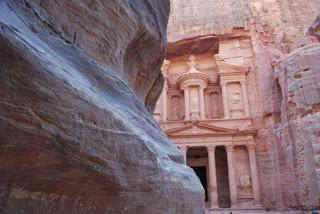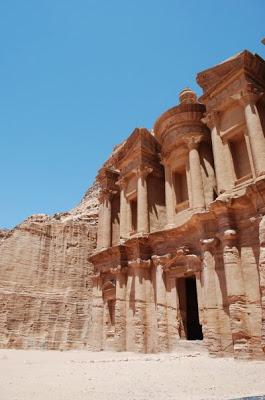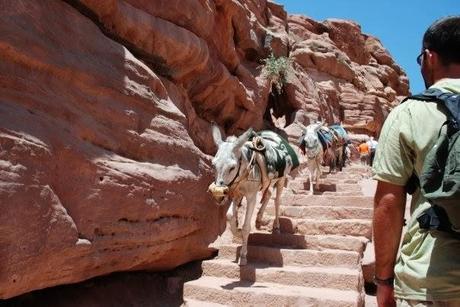 Petra is one of Jordan’s most famous attractions and visiting this incredible rock-cut city is on the list of must-dos for many tourists who pass through the country. If you’re planning a trip to Jordan, read our guide to this amazing site to discover why you should add it to your itinerary.
Petra is one of Jordan’s most famous attractions and visiting this incredible rock-cut city is on the list of must-dos for many tourists who pass through the country. If you’re planning a trip to Jordan, read our guide to this amazing site to discover why you should add it to your itinerary.Petra: a Brief History
The story of Petra’s past sounds like something out of the Arabian Nights tales and indeed the city was once one of the most important stops along the trade routes linking China to the west. What you see today was created by the Nabataeans, who is thought first arrived here in the 6th century BC.
They lived within this well-protected valley side-by-side with the Edomite people who settled here during the Iron Age. Petra flourished under the Nabataeans, with a range of crops and animals farmed here. They were particularly good at water management and set up a complex system to divert water from a nearby oasis to supply the growing city.
Although farming was important, this was not what brought Petra its greatest prosperity - this came from the taxes levied on merchants transporting goods across the desert, who would stop in Petra to rest and restock their caravans.
The arrival of the Romans in 64 BC spelled the beginning of a period of change for Petra that would ultimately lead to its downfall. There are remnants from the Roman civilization in Petra, but they gradually diverted the trade routes away from the city, resulting in the Nabataeans losing influence and money.
Although Petra continued to be used by traveling merchants until the 15th century, it had fallen into a deep decline and the once powerful Nabataeans had gone. Bedouins then took control of the city and fiercely defended it, with the west forgetting entirely about it until Johann Ludwig Burckhardt - a Swiss traveler - managed to gain access in the early 19th century.
Top Landmarks in Petra

The whole city of Petra is truly breathtaking and one of those places that really has to be seen to be fully appreciated. Entering through a narrow canyon, the first building you’ll see is the iconic Treasury, which has featured on the silver screen several times.
Its incredible 43 m high facade, which is carved out of the solid rose-coloured rock, will take your breath away. As you wander around the rest of Petra, most of the chambers that are still standing are tombs, which were hewn from the rocks.
Many of the houses in the city were destroyed by earthquakes centuries ago, but the tombs and their elaborate carvings remain for all to see. The Urn and Corinthian tombs are two of the most impressive funerary monuments. There are also beautiful carvings of Aramaic scripts in the rock faces, which were left by the Nabataeans.
You can see the Roman influence in the amphitheater and mosaics that dot the site, while remnants from the Byzantine civilization is evident from the remains of churches. There is also a shrine marking the reputed burial place of the Prophet Aaron on Jebel Haroun, Petra’s highest point.
If you’re exploring the city as part of a trekking holiday, you may want to make the two to three-hour climb to this spot - it’s worth the effort for the amazing views of the desert landscape below.
Another landmark that requires a bit of effort to reach, but that should definitely be in your sights, is Ad-Deir, a monastery that sits on a promontory overlooking the valley. This is accessed via a series of rock-cut steps up a rather steep climb. Get to the top, though, and you can look down on Petra and across the desert.
Practicalities

Whether you’re planning to visit Petra as part of an organized trip - like those offered by Explore Worldwide - or on your own, you need to make sure you have enough time to properly discover its many wonders. Ideally, you need at least two days if you want to feel as though you’ve uncovered even half of what there is to see.
If you have any choice over your itinerary, aim to be in Petra on a Monday, Wednesday or Thursday night, as special candlelit tours are organized on these evenings and allow you to appreciate the rock-cut city in a whole different way - the atmosphere at these events is magical.
When you’re looking at planning a trip to Jordan it’s worth bearing in mind that entrance fees to the country’s heritage sites - like Petra - can be quite steep, so make sure you allow for this in your budget. Of course, one of the biggest advantages of going on a pre-arranged holiday is that you won’t need to think about any of that because entrance to the sites will be included in the price you pay for the package.
If you decide to visit Jordan during the summer, remember that it will be very hot in the desert and that you need to drink a considerable amount of water to remain hydrated and avoid falling ill.



